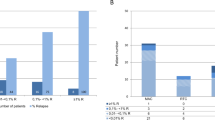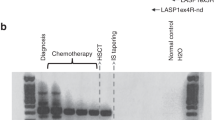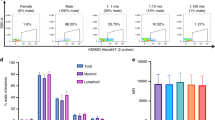Abstract
Recent observations of chimerism in patients relapsed following an allotransplant suggest the persistence of immunotolerance, thus offering a biologic rationale for the use of donor lymphocyte transfusion (DLT). In this study, we have analyzed by PCR amplification of several VNTR regions, sequential bone marrow and peripheral blood DNA samples in four patients who received DLT for CML relapse after bone marrow transplantation. Prior to DLT, all patients showed mixed chimerism in peripheral blood cells while two had mixed chimerism and two no chimerism in the BM. None of these four patients showed evidence of chimerism at the cytogenetic level (all had 100% +ve metaphases). After DLT, a complete hematologic and molecular remission (ie disappearance of the BCR/ABL fusion transcript) was obtained in the two patients who had bone marrow mixed chimerism prior to DLT. The two patients without evidence of marrow chimerism prior to DLT converted to a pattern of mixed chimerism after DLT, but both developed a severe bone marrow aplasia occurring at day 56 and 36, respectively. With regard to the sequential analysis of bone marrow chimerism after DLT we observed that: (1) the disappearance of BCR/ABL +ve cells paralleled the conversion to a pattern of full donor chimerism; and (2) the time interval to achieve CR was inversely correlated with the percentage of donor DNA in bone marrow. In conclusion, we have shown here that the assessment of bone marrow pre-DLT chimerism by PCR analysis might predict the response in patients with favorable characteristics, and also might identify patients at high risk of developing severe myelosuppression.
This is a preview of subscription content, access via your institution
Access options
Subscribe to this journal
Receive 12 print issues and online access
$259.00 per year
only $21.58 per issue
Buy this article
- Purchase on Springer Link
- Instant access to full article PDF
Prices may be subject to local taxes which are calculated during checkout
Similar content being viewed by others
Author information
Authors and Affiliations
Rights and permissions
About this article
Cite this article
Rapanotti, M., Arcese, W., Buffolino, S. et al. Sequential molecular monitoring of chimerism in chronic myeloid leukemia patients receiving donor lymphocyte transfusion for relapse after bone marrow transplantation. Bone Marrow Transplant 19, 703–707 (1997). https://doi.org/10.1038/sj.bmt.1700723
Received:
Accepted:
Issue Date:
DOI: https://doi.org/10.1038/sj.bmt.1700723
Keywords
This article is cited by
-
Assessing quantitative chimerism longitudinally: technical considerations, clinical applications and routine feasibility
Bone Marrow Transplantation (2007)
-
Intensive graft-versus-host disease prophylaxis is required after unrelated-donor nonmyeloablative stem cell transplantation
Bone Marrow Transplantation (2005)
-
Nonmyeloablative preparative regimens for allogeneic hematopoietic transplantation
Bone Marrow Transplantation (2001)
-
Sequential monitoring of chimerism and detection of minimal residual disease after allogeneic blood stem cell transplantation (BSCT) using multiplex PCR amplification of short tandem repeat-markers
Leukemia (2001)



